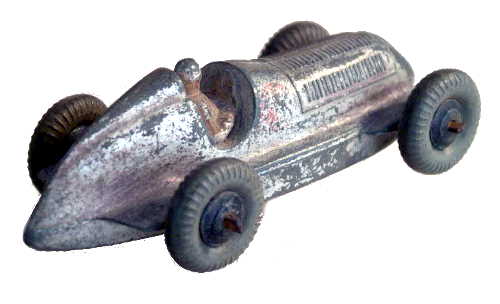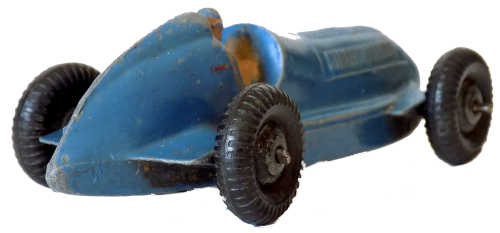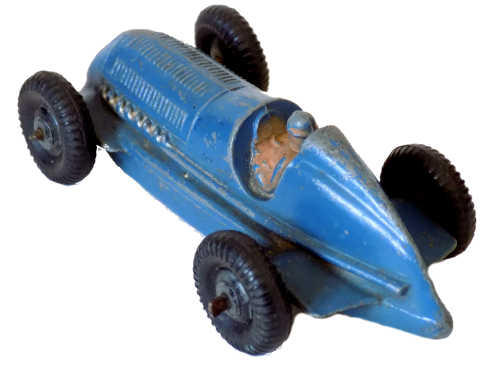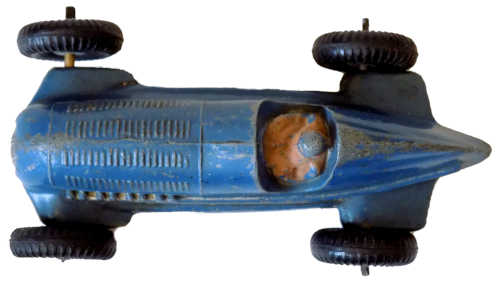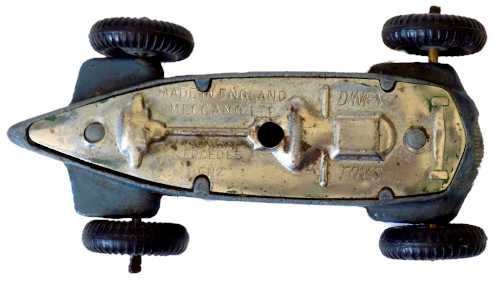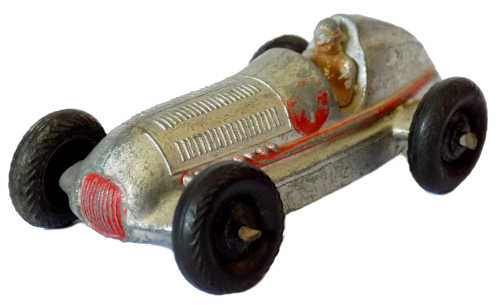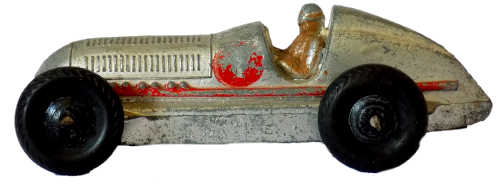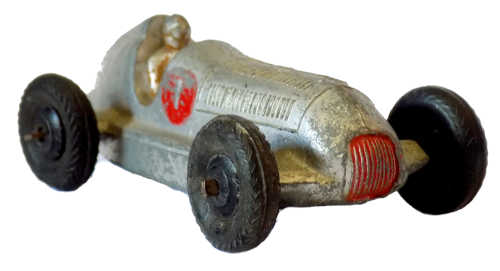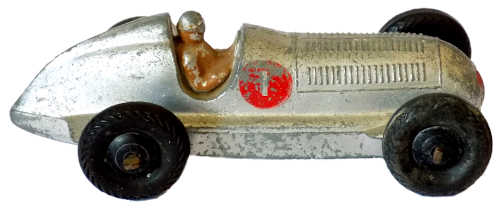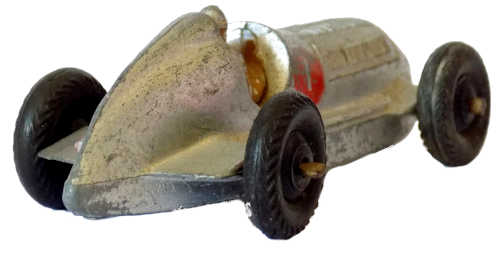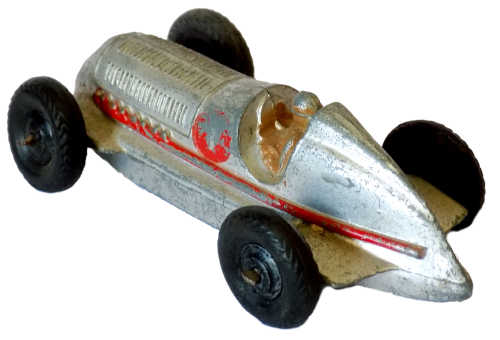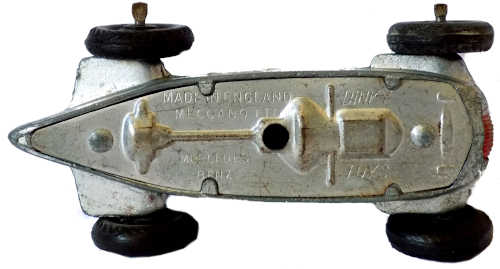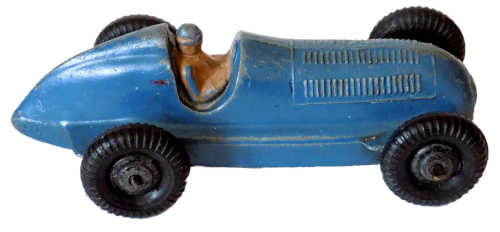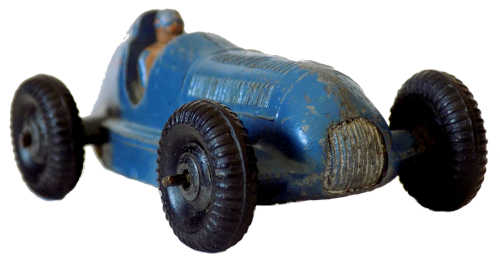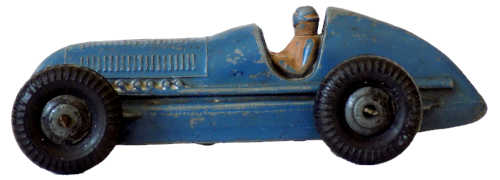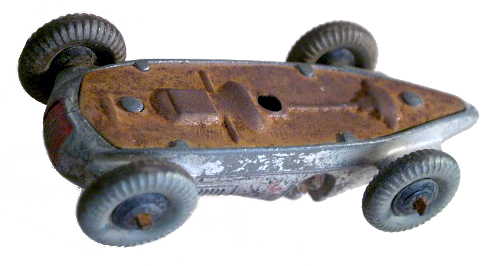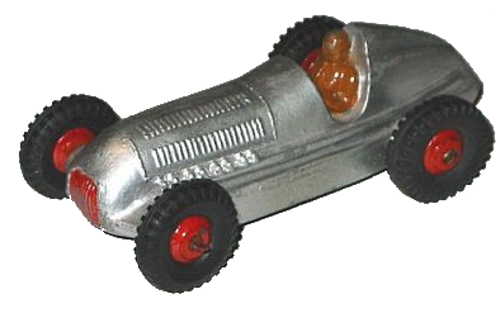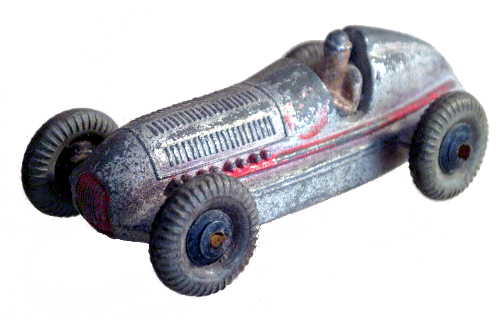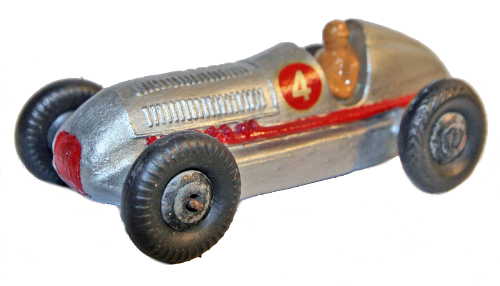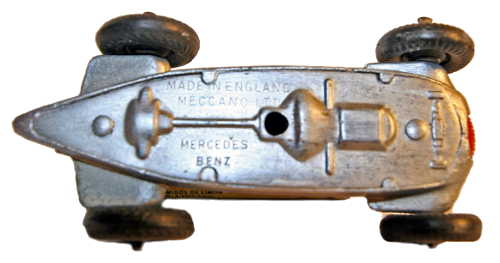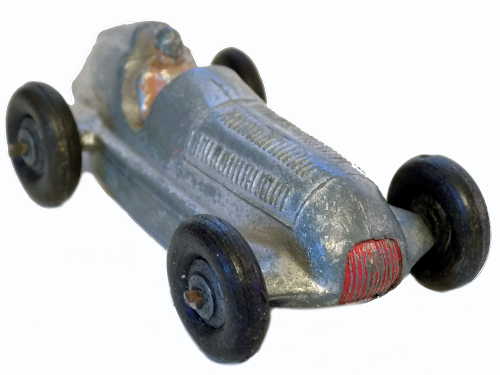Details of Dinky 23c Mercedes Racing Car
The Dinky Mercedes Racing Car.
In July 1936, The Meccano Magazine announced the launch of the Dinky Toy's Mercedes-Benz racing car, 23c. The magazine advertised the racing car for the nine months following in the Dinky Toys spread. The 93mm long Mercedes-Benz model came in a range of colours: red, blue, yellow, light green, silver and a light blue. Originally and with smooth hubs and a clipped baseplate, the model cost 8 old pence. In 1939, the price increased to 10 old pence and by the last time the model was advertised in the magazine, in December 1947, the model cost 1/8. The baseplate was only riveted after 1938. The model's tyres also changed over the years, with pre-war models having black round treaded tyres on smooth hubs, while in post-war times, black herringbone tyres were mounted on black ridged hubs. A variety of race numbers were applied to the model, from 1-6. In 1950, the model's die was in France and the model was produced for the export market only. In 1952, the die was due to return to the UK from France, but it did not and therefore, the model was effectively withdrawn from 1950.
In reality, the Daimler-Benz designed the car for racing in the 1934 Grand Prix season. The team behind the design were Hans Nibel, Max Sailer, Albert Heess and Max Wagner and included several revolutionary and weight lightening features, such as the 'U'-shaped pressed steel chassis and double wishbone suspension. In 1934, the car, a Mercedes-Benz W25, won its first outing at the Nurburgring, Nordschiefe. The 3.4 litre W25, with its 5-speed gearbox, won four other major races, the Eifelrennen, the Coppa Acerbo, and the Spanish and Italian Grand Prixs. The Mercedes W25, even with its later and larger 4.3 litre engine, suitably replaced its predecessor, a heavier 7 litre car designed by Ferdinand Porsche. Driven by Tazio Nuvolari, Rudolf Caracciola, Manfred von Brauchitsch and Luigi Fagioli. 1935, was a good season for the Mercedes W25 and the car achieved nine Grand Prix wins. Success came to an end, when Mercedes fitted the car with the larger 4.3 litre engine, which proved unreliable.
Introduced in 1936, the model was withdrawn in 1950.
The original price was -/8 . It was finished in blue, silver. Released as Dinky 23c in 1936 withdrawn as Dinky 23c in 1950.
Base:
tin plate baseModel features:
driverVehicle make:
MercedesVehicle type:
racing carWheels:
cast ridged hubs, grey treaded tyres, tyres with treadIf you know about this model you can add more detail by email to: diecastplusinfo@gmail.com where you can also send pictures of your models to add to the site.
More models
Related models on this site that may be of interest.
- Budgie 7 Mercedes Benz W196
- Corgi 1145 Mercedes Benz Unimog with Goosneck Dump
- Corgi 1150 Mercedes Benz Unimog with Snow Plough
- Corgi 2014 Mercedes Benz Transporter
- Corgi 2020 Mercedes Truck Birds Eye
- Corgi 2028 Mercedes Refrigerated Truck DANONE
- Corgi 230 Mercedes 220SE
- Corgi 247 Mercedes benz 600 Pullman
- Corgi 253 Mercedes Benz 220SE
- Corgi 291 Mercedes Benz 240 Rally Car
- Corgi 303 Mercedes 300SL Open Sports
- Corgi 304 Mercedes 300SL Hardtop
- Corgi 393 Mercedes Benz 350SL
- Corgi 406 Mercedes Bonna Ambulance
- Corgi 409 Mercedes Benz Unimog Rear Dumper
- Corgi 411 Mercedes Benz 240D Taxi
- Corgi 412 Mercedes Benz Police Car
- Corgi 576 Mercedes 207D Van TNT
- Corgi 630 Mercedes Van Kays
- Corgi 811 Mercedes Benz 300SL
- Corgi GS24 Mercedes and Caravan
- Corgi Junior 15 Mercedes Benz Bus
- Corgi Junior 90390 Mercedes Benz 220D Ambulance
- Dinky 128 Mercedes Benz 600
- Dinky 160 Mercedes Benz 250 SE
- Dinky 186 Mercedes Benz 220SE
- Dinky 237 Mercedes Benz Racing Car
- Dinky 32C Mercedes racing Car
- Dinky 940 Mercedes Benz Truck
- French Dinky 526 Mercedes 190SL Coupe
- French Dinky 541 Mercedes Benz Minibus
- French Dinky 567 Mercedes Snow Plough
- French Dinky 804 Mercedes
- French Dinky 821 Mercedes Unimog
- Husky 3 Mercedes 220
- Impy 17 Mercedes 220 SE
- Marklin 5524/1S Mercedes 100
- Matchbox 1 Mercedes Truck
- Matchbox 11 Mercedes Scaffolding Truck
- Matchbox 2 Mercedes Trailer
- Matchbox 27 Mercedes 230 SL
- Matchbox 3 Mercedes Ambulance
- Matchbox 42 Mercedes Container Truck
- Matchbox 46 Mercedes 300SE
- Matchbox 53 Mercedes Benz 220 SE
- Matchbox 68 Mercedes Coach
- Matchbox King Size K6 Mercedes Benz Binz Ambulance
- Matchbox Models of YesterYear Y-10 1908 G.7 Mercedes
- Mercury 55 Mercedes W196 F.1
- Mercury 56 Mercedes W196 F.1
- Schuco 1038 Mercedes
- Schuco 301618 Mercedes 350SE Taxi
- Spot-On 278 Mercedes-Benz 230 SL
- Timpo Toys ? American Star Racing Car
- Tomica 92 Mercedes Benz C Class Type
- Wiking 15s Mercedes 280S
- Wiking 27 Mercedes Van
Special features
Articles on this site that might be helpful.
Other sites
Links to external sites that may be of interest. Please report any broken links to the webmaster.
Contributors
Thank you to the following contributors of images and or information for this page.
- Thanks to John Cruickshank
- Thanks to John Morris
- Thanks to Peter Leach
- Thanks to Walter Herter
